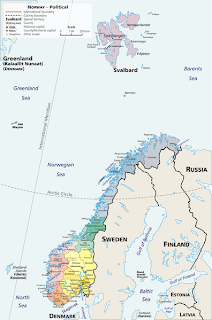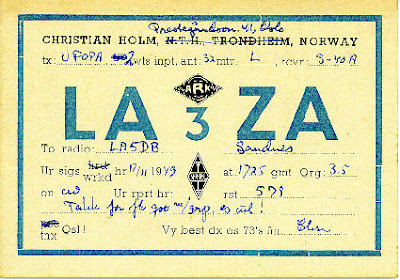Posts Tagged ‘callsign’
 The radio amateur who felt compelled to abandon his own call sign
The radio amateur who felt compelled to abandon his own call sign
If you mention that you are a radio amateur to any Norwegian who was old enough to watch TV in the mid 70’s then he is bound to respond with LA8PV. This was the callsign of the fictious figure Marve Fleksnes in the comedy the “Radiot”. To bad for the poor guy who actually was given that callsign some years later. I had contact with him on CW (= morse) in 2002 just after I got my license and I just couldn’t believe that anybody actually was using that particular callsign.
The first of three cuts can be viewed in the embedded Youtube video. Unfortunately I couldn’t find any clip that was subtitled in English, but the first minute or so is almost silent and is about the joy of getting a replacement DF1987B (sic) tube for his transmitter. The tube is supposedly plugged into the output tube socket of a Quad II audio amplifier and then he is ready to go on the air. Later one gets a glimpse of his AR88D receiver.
As the story goes, the Norwegian Post and Telcom Authorities, had marked off LA8PV as a callsign that shouldn’t be used. But due to a mistake they blacklisted LA8PW instead. I had contact with LA8PV almost every year up to and including 2007, but have never had it since. I understand why now, because QRZ.com says that the real LA8PV finally must have given up and gotten the new call sign, LA2WRA, on 4 Jan. 2008. I don’t envy him the fate of having been made LA8PV, and fully understand why he finally abandoned that callsign.
The source for much of this story is a Swedish discussion page on hamradio.se. Marve Fleksnes and LA8PV also aired on Swedish television and were very popular there as well.
 Why do Norwegian callsigns end in A?
Why do Norwegian callsigns end in A?
Well actually not all end in A, but almost all of the recent ones do. Amateur callsigns in Norway are not so well documented on the web, so here is a short explanation.
Norwegian callsigns are used in these territories:
- LA-LN for use in mainland Norway
- JW is used on Svalbard and close-by islands Hopen and Bjørnøya
- JX is used on Jan Mayen
- 3Y is used on Bouvet Island, Peter I Island, and in Antarctica (Queen Maud Land)
Usually the callsign starts with LA, but why do so many of the LA callsigns end in A?
The callsigns have been distributed with the last letter as the most significant letter, e.g. in this order for the two letter series: LA1AA, LA1BA, LA1CA, …, LA9ZZ. In the 80’s it was necessary to add a third letter and that series started like this: LA1AAA, LA1BAA, LA1CAA, …, LA1ABA, LA1BBA, … As an example LA9KTA was issued last year. With the ‘TA’ we are getting closer to the last one, LA9ZZA, in the series ending in ‘A’ now. Therefore in some years all new radio amateurs will get callsigns ending in B.
We also had an LC license at the same time. That was a no-code VHF/UHF-license. All those callsigns ended with -T for Technician license, e.g. LC3SAT. That series is no longer used and it is not possible to get the old LC callsign back.
There is no vanity callsign system in Norway, but club stations were allowed by the Norwegian Post and Telecommunications Authority to get one of the rare single-letter callsigns that were issued to the very first radio amateurs (up to about the time of the second world war). There are only 26*9 = 234 of these callsigns and one example is LA4O for the Oslo group. But this practice seems to have ended now. It is also possible to inherit a callsign from family as I have done.
There are also a few special callsign series:
- LD: Packet radio repeater nodes for VHF and UHF, e.g. for APRS. An example is LD3GT
- LF: License issued to a company, e.g. LF2E
- LG: Only Norwegian-Swedish station LG5LG in Morokulien
- LN: Club stations may switch to this in some of the major contests, e.g. LA8W – LN8W
 DXpedition Basics By Wayne Mills, N7NG
DXpedition Basics By Wayne Mills, N7NG
| DXpedition Basics Written By Wayne Mills, N7NG |
Good morning from the #hamr shackadelic zone where I’m listening to our local repeater or in today’s vernacular lurking the frequency. Also, my weather report from near the beach is overcast, cool, expecting rain, and choppy surf conditions. It is the kind of day where I’m knocking to-do objectives off my list and enjoying life.
Wayne Mills, N7NG author of DXpedition Basics suggested, “But when DXpedition organizers accept contributions and support, there is an implicit, and even maybe an explicit obligation to conform to certain operating criterion. Specifically, organizations which funnel money to DXpedition groups for the benefit of the DXing community have become more particular about whom they support. Their assistance often demands minimum standards of operating proficiency, and may depend on the track record of the group. Following a few simple rules can go far in assuring the success of a DXpedition effort.” (p 2, 1994)
Mills stated, “In fact, many have said that the DXpedition operator is responsible for the conduct and outcome of an expedition, and that, indeed, the pileups in a sense mirror the DXpedition operator. The DXpedition operator must be in command, but just how is that accomplished?” (p 2, 1994)
Lastly, Mills suggested a fundamental premise for expeditions, “We will start with the premise that the overall objective of the DXpedition is for DXers around the world to simply have fun. With rare exceptions, no expeditioner ever expects to profit from his DXpeditioning activities. Rather, considerable expenses are incurred primarily in transportation costs and loss of employment income. This is a fact; chiseled in stone!” (p 3, 1994)
I’m sad to read that a highly successful year of DXpeditioning is coming to a close with a disruptive footnote attached to its banner resume for our ham radio community. It seems to me that Wayne Mills, N7NG in association with the American Radio Relay League and the International DX Association sought solutions to perplexing questions more than a decade ago.
We are fast arriving or if not have already arrived, where it is time to start this conversation anew, in lieu of significant technological and social change. Thus far, leading donor organizations remain silent in an age of unparalleled communications and intense social engagement.
I recommend downloading DXpedition Basics, print, review, then take it with you to the next gathering and renew this decade old conversation that better reflects ham radio in the 21st Century.
73 from the shackadelic near the beach.
 Club Log Receives $4000 Yasme Foundation Grant
Club Log Receives $4000 Yasme Foundation Grant
“Club Log represents a unique innovation that has quickly become established in the culture of our hobby. By providing free access to features such as leagues, online QSL requests and expedition management tools, Club Log has expanded the state of the art of DXing and has grown quickly as a result. The Foundation’s grant to Club Log gives the team the means to install backup servers and keep this precious resource online for everyone to enjoy into the future. We look forward to seeing more innovations from the Club Log team.”
Rusty, W6OAT, the Yasme Foundation
 My take on 63 Degrees of Propagation: The 2012 ARRL 10 Meter Contest
My take on 63 Degrees of Propagation: The 2012 ARRL 10 Meter Contest
My take on 63 Degrees of Propagation: The 2012 ARRL 10 Meter Contest – Like Eggnog: In the end, I made well under half of the contacts I did last year. I’m certain I did not work anything new to me this weekend but I was sure hoping. Running low power, I sure had plenty of stations CQ’n in my face but that’s all part of the challenge when the bands are tough. But a bad day of contesting is still better than a great day in the office!
Contest on, Brother!
 Nostalgia from LA3ZA in 1949
Nostalgia from LA3ZA in 1949
Those who are familiar with me will know that I wasn't even born when this LA3ZA QSL-card was issued in 1949. This is because I am second generation LA3ZA after my father. When the callsign was reissued to me in 2001 it had been inactive for 40 years or so.
I still have the Hallicrafters S40A receiver which my father used with a 2 W input homemade tube transmitter. The S40A (image below) was what introduced me to shortwave listening during the good conditions of the solar peak in the late sixties, despite its mediocre performance I would say.
Read more »
 Best 73 To N4EMG
Best 73 To N4EMG
I want to thank Ed, N4EMG who helped bring ham radio blogging to the Internet and for sharing his personal journal as well. There is a season for everything. I’m experiencing that change when the leaves begin morphing while the deep slumber of winter is soon to arrive. I met a friend through the spirit of ham radio blogging and will miss Ed’s contribution.
Ed, please leave your blog, your contribution is part of ham radio’s history. Who knows what one year will bring or for that matter five years from now? We are among the early new media pioneers and now it is reaching ubiquity within our community.
Or, perhaps now is a good time for a vacation from the blog, gather new material without having to journal about what was learned. I’m having fun writing out traditional QSL cards and watching the mailbox. Finally, I’m getting after my basic awards like DXCC, WAS, and WAC as well. Likewise, I’m confirming counties and building up my grid square count. Today, KI6QDH and I worked on his 3-element tri-bander with its new 40 meter add on kit. What a hoot!
There is a season for everything and best 73 to Ed, N4EMG from the shack relaxation zone.













